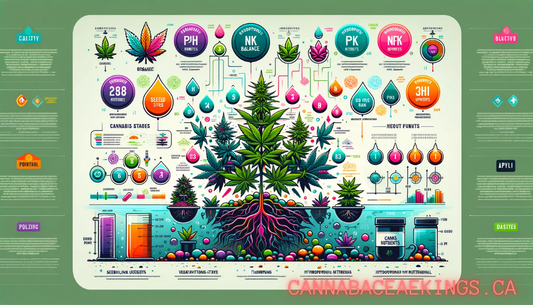Introduction
The journey to cultivating high-quality cannabis starts with understanding what your plants need to thrive. One of the most crucial aspects often overlooked by growers, both novice and seasoned, is nutrient management. This guide aims to address all your burning questions about cannabis nutrients, from what to use and when, to spotting problems and finding solutions. Buckle up as we delve deep into the world of cannabis nutrients.
Section 1: The Basics of Cannabis Nutrients
1. What nutrients do I use on cannabis plants?
Every cannabis plant needs a balance of macro and micronutrients for optimal growth. Macronutrients include Nitrogen (N), Phosphorus (P), and Potassium (K), often denoted as the N-P-K ratio on nutrient solutions. Micronutrients like calcium, magnesium, and sulfur are also vital but needed in smaller quantities.
Tips:
- During the vegetative stage, opt for a nutrient solution higher in Nitrogen.
- Transition to a Phosphorus-rich solution during the flowering stage.
2. What is the best nutrient solution for cannabis?
The 'best' nutrient solution depends on various factors such as the growth stage, soil quality, and whether you're growing indoors or outdoors. Organic nutrients, derived from natural sources like bone meal or fish emulsion, are excellent for soil health but may take time to break down. Synthetic nutrients provide immediate benefits but risk nutrient burn if overused.
Recommendations:
- Organic nutrients for outdoor grows
- Synthetic nutrients for hydroponic systems
Section 2: Feeding Your Cannabis Plants
3. How much should I feed my cannabis every time?
The amount of nutrients your cannabis plants need varies with their growth stage, size, and general health. Overfeeding can lead to nutrient burn, while underfeeding will result in weak growth and poor yields.
Tips:
- Start with a half-strength nutrient solution and gradually increase.
- Monitor for signs of nutrient burn like yellow or brown leaf tips.
4. How do you know when cannabis needs nutrients?
Detecting nutrient needs in cannabis involves observing plant color, leaf condition, and growth rate. Yellowing leaves, stunted growth, and weak stems are often signs of nutrient deficiency.
Tip:
- Use a pH meter to ensure that the soil or water pH is in the optimal range for nutrient absorption, typically between 6.0 and 7.0 for soil-grown cannabis.
5. How many times a week should I feed my cannabis?
Feeding frequency depends on factors like plant size, growth stage, and the medium used for cultivation. In soil, nutrient-rich water might be required every 2-3 days, while hydroponic systems may need daily feeding.
Tips:
- In the vegetative stage, feeding 2-3 times a week is generally adequate.
- During flowering, nutrient needs increase; consider feeding every 1-2 days.
Section 3: Spotting Problems and Finding Solutions
6. What does low-quality cannabis look like?
Low-quality cannabis often exhibits signs like discolored leaves, poor bud formation, and a lack of trichomes. These are usually indicators of improper nutrient management or environmental stress.
7. What color is healthy cannabis?
Healthy cannabis plants display a rich green color in the leaves, robust bud formation, and a plentiful number of sticky trichomes. Variations in leaf color, such as purple or blue hues, may be strain-specific and not necessarily a sign of poor health.
Section 4: Advanced Nutrient Management
8. Should I use nutrients every time I water?
Using nutrients in every watering cycle can lead to nutrient lockout, where the plants are unable to absorb any more nutrients. It's essential to have "flush" days, where you only water the plants without adding nutrients.
9. Can water have too many nutrients?
Yes, over-fertilization or "nutrient burn" is a common issue. Signs include brown or yellow leaf tips and reduced growth. The remedy is to flush the growing medium with plain, pH-balanced water.
10. How long can nutrients sit in water?
Nutrients can break down over time when mixed in water, losing their effectiveness. It's best to use freshly mixed nutrient solutions and avoid storing them for more than a week.
Section 5: Fine-tuning for Quality
11. How do you make your buds taste good?
The flavor and aroma of cannabis buds are influenced by terpenes and flavonoids. Flushing the plants with plain water 1-2 weeks before harvest can remove excess nutrients, leading to cleaner, better-tasting buds.
12. What is the most common nutrient deficiency in cannabis?
Nitrogen deficiency is often the most common issue, characterized by yellowing older leaves. A balanced, high-nitrogen nutrient solution can quickly remedy this.
13. Do you adjust pH before or after adding nutrients?
Always adjust the pH after mixing in the nutrients. This ensures that the nutrient solution is at an optimal pH level for maximum absorption by the cannabis plants.
14. Does sugar increase trichomes?
There's a myth that adding sugar to your nutrient mix can boost trichome production. While sugar is essential for plant energy, there's no conclusive evidence to suggest it directly impacts trichome levels.
Conclusion
Understanding the intricacies of cannabis nutrients can be the game-changer you need for producing top-quality buds. From choosing the right nutrients to fine-tuning your feeding schedule, each decision impacts your end product. We hope this guide has been an invaluable resource on your cannabis cultivation journey.









